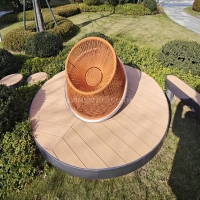Welcome to the website for landscape facilities products and knowledge.
What are the differences in thermal comfort between materials used in landscape tables?
When selecting landscape tables for outdoor spaces, thermal comfort is a critical factor often overlooked. Different materials exhibit varying responses to temperature, directly impacting user experience.
1. Wood: Natural wood, like teak or cedar, offers moderate thermal comfort. It absorbs less heat than metal but can become warm in direct sunlight. Its insulating properties make it comfortable in both warm and cool climates.
2. Metal: Aluminum and steel conduct heat efficiently, making them uncomfortably hot in summer and cold in winter. Powder-coated finishes can slightly mitigate extreme temperatures but don’t eliminate the issue.
3. Concrete: Dense and slow to heat, concrete remains cooler than metal but can retain cold in winter. Its thermal mass stabilizes temperatures over time, offering moderate comfort.
4. Plastic/Resin: Lightweight and low-conductivity, plastic tables stay cooler than metal but may feel less durable. UV-resistant variants prevent overheating but lack the aesthetic appeal of natural materials.
5. Composite Materials: Combining wood fibers and plastics, composites balance thermal performance. They resist extreme temperatures better than pure metal or plastic but may still warm under prolonged sun exposure.
For optimal thermal comfort, consider shaded placements or materials like wood/composites. Understanding these differences ensures a more enjoyable outdoor experience.
Related search:

Recommendation
Swivel chair-Specialty steel structure woven rattan leisure chair with rotatable design